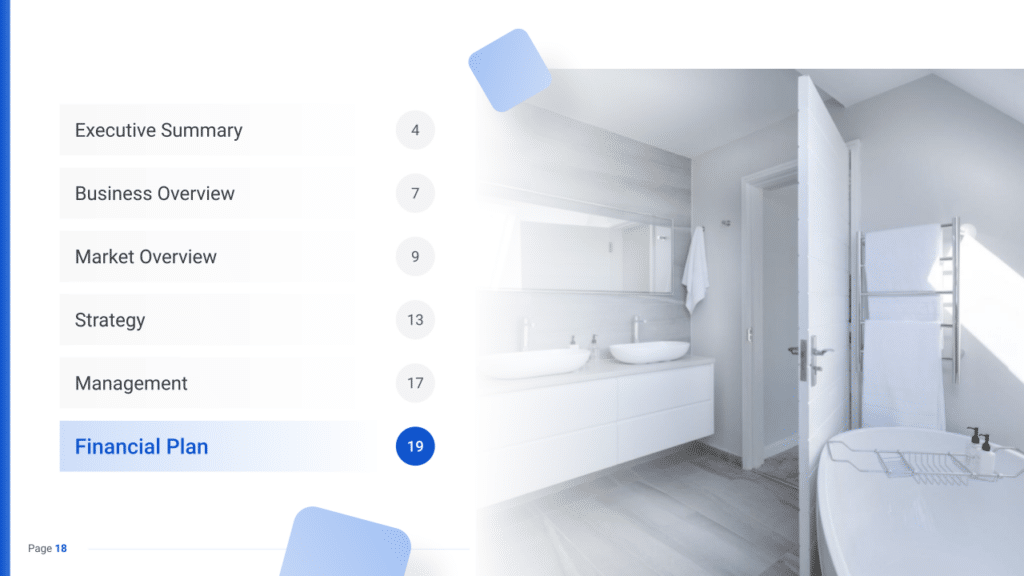Kitchen & Bathroom Remodeling Business Plan Template & PDF
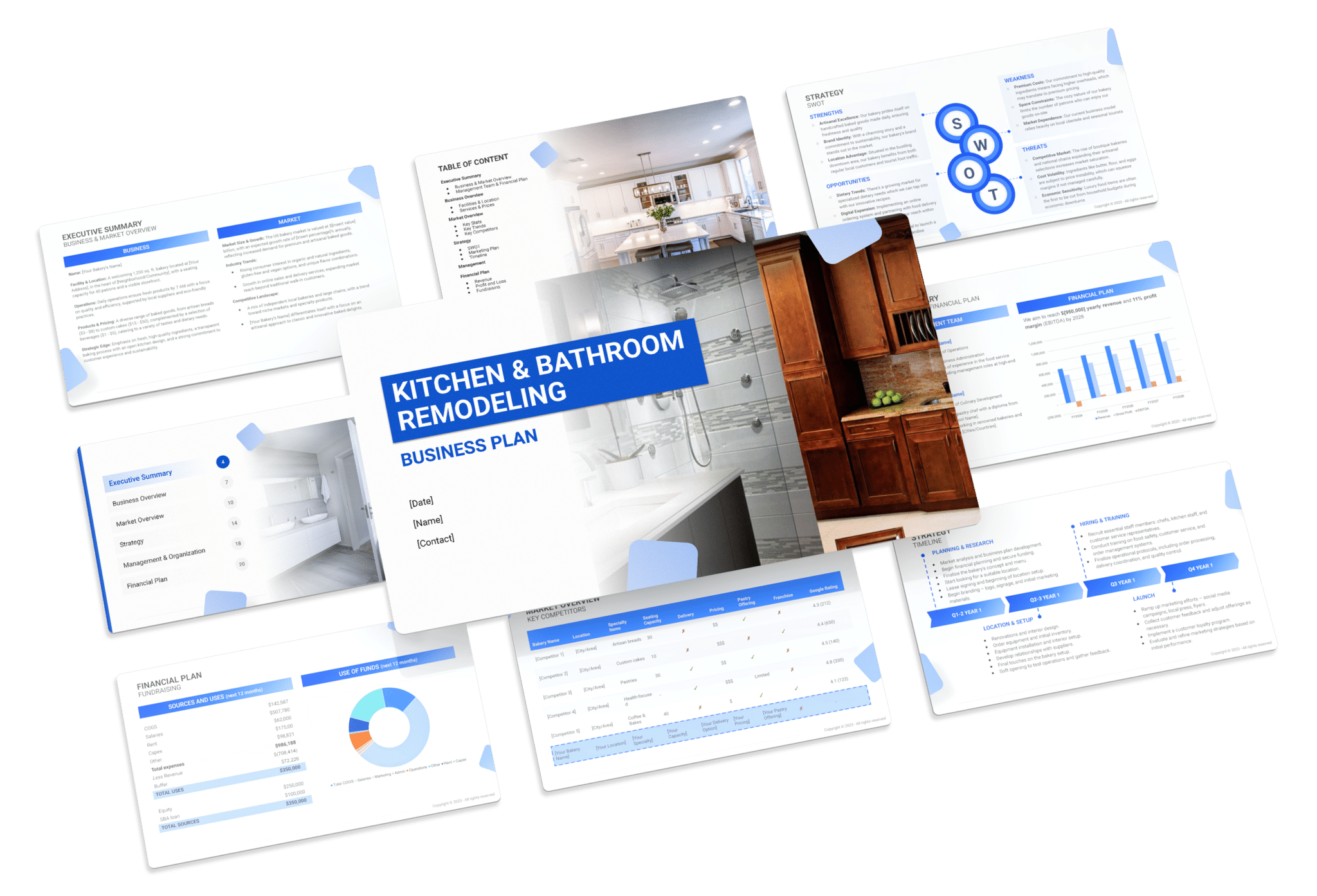
Creating a comprehensive business plan is crucial for launching and running a successful kitchen & bathroom remodeling business. This plan serves as your roadmap, detailing your vision, operational strategies, and financial plan. It helps establish your kitchen & bathroom remodeling business’s identity, navigate the competitive market, and secure funding for growth.
This article not only breaks down the critical components of a kitchen & bathroom remodeling business plan, but also provides an example of a business plan to help you craft your own.
Whether you’re an experienced entrepreneur or new to the service industry, this guide, complete with a business plan example, lays the groundwork for turning your kitchen & bathroom remodeling business concept into reality. Let’s dive in!
The Plan
Our kitchen and bathroom remodeling business plan is structured to cover all essential aspects needed for a comprehensive strategy. It outlines the company’s operations, marketing strategy, market environment, competitors, management team, and financial forecasts.
- Executive Summary: Provides an overview of the Kitchen & Bathroom Remodeling business concept, market analysis, management team, and financial strategy.
- Business Overview: Offers detailed insights into the Kitchen & Bathroom Remodeling business and its operational model:
- Services & Location: Describes the range of remodeling services offered, including custom cabinetry, countertops, and appliance installation, and explains the strategic location benefits.
- Service List & Pricing: Lists the remodeling services provided, detailing the customization options and pricing structure.
- Market Overview: Examines the remodeling industry landscape, highlighting competitors and the unique position of the Kitchen & Bathroom Remodeling business:
- Key Stats: Shares industry size, growth trends, and relevant statistics for the remodeling market.
- Key Trends: Highlights recent trends affecting kitchen and bathroom remodeling, such as luxury finishes and smart appliances.
- Key Competitors: Analyzes main competitors in the vicinity and differentiates the business from them.
- Strategy: Details how the Kitchen & Bathroom Remodeling business plans to achieve growth and attract clients:
- SWOT: Conducts a strengths, weaknesses, opportunities, and threats analysis specific to kitchen and bathroom remodeling.
- Marketing Plan: Outlines strategies for attracting new customers and retaining existing ones, including showcasing past project portfolios and leveraging social media.
- Timeline: Sets out key milestones and objectives from business launch through the first year of operation.
- Management: Introduces the management team, detailing their experience in remodeling, design expertise, and roles within the business.
- Financial Plan: Forecasts the business’s 5-year financial performance, covering revenue projections, expense breakdowns, funding requirements, and financial statements (profit and loss, cash flow, balance sheet).

Executive Summary
The Executive Summary introduces the business plan for your Kitchen & Bathroom Remodeling company, offering a succinct overview of your company and its services. It should outline your market positioning, the array of remodeling services you provide, its location, and size, and a summary of daily operations.
This section should also delve into how your remodeling business will fit into the local market, including the number of direct competitors in the area, identifying who they are, along your company’s unique selling points that set it apart from these competitors.
Additionally, you should include information about the management and co-founding team, detailing their roles and contributions to the company’s success.
A summary of your financial projections, including revenue and profits over the next five years, should also be presented here to provide a clear picture of your company’s financial plan.
Kitchen & Bathroom Remodelling Business Plan Executive Summary Example

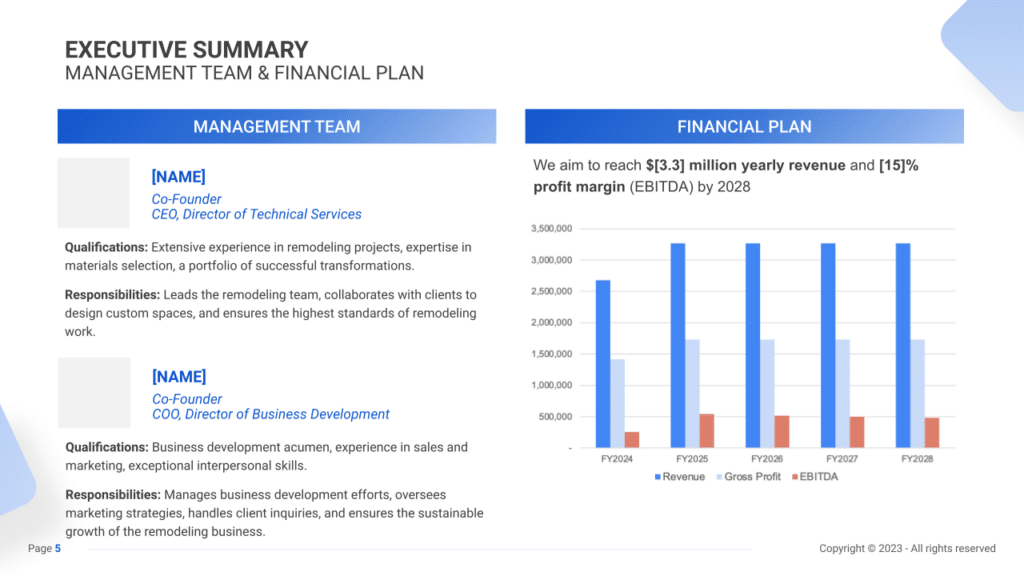
Business Overview
This section should introduce the name of the remodeling service, its location, and a brief overview of the services offered. It sets the stage for showcasing the business’s Unique Selling Proposition (USP). Whether it’s a focus on luxurious finishes, custom designs, or a commitment to sustainability, the USP should stand out as a defining feature of the remodeling service.
Example:
“Modern Kitchen Co.,” centrally positioned in [City Name], specializes in transformative kitchen and bathroom remodels within a [x] mile radius. Known for its innovative designs and personalized remodeling solutions, their USP lies in delivering luxurious and sustainable spaces that elevate modern living standards.
Market Overview
Understanding the market size, growth trends, and industry dynamics is pivotal. This section should emphasize the immense potential within the remodeling industry, supported by relevant data on market value and growth rates. Highlighting industry trends such as the surge in luxury designs and the increasing demand for sustainable remodeling materials provides insight into the evolving market landscape.
Furthermore, outlining the competitive landscape is vital. The executive summary should identify key competitors and show how the remodeling service positions itself in this environment. Whether it emphasizes high-end designs, eco-friendly remodeling practices, or exceptional customer service, this section serves to underscore the unique market positioning of the service.
Example:
Within the remodeling industry valued at $79.7 billion, and with the market for new kitchen and bathroom construction projects at $119.6 billion, Modern Kitchen Co. competes with a wide range of contractors. Their differentiation is evident through bespoke luxury designs, sustainable remodeling solutions, and a commitment to providing tailored and environmentally conscious spaces.
Management Team
Showcasing the qualifications and experiences of the key team members within the summary adds credibility. Highlighting expertise in remodeling, design, project management, or customer service assures potential clients of the service’s capability to deliver outstanding results.
Example:
Modern Kitchen Co. is steered by a team with comprehensive experience in business development and marketing strategies. Their adeptness in offering innovative, luxurious, and sustainable remodeling solutions ensures client satisfaction and the continual growth of the business.
Financial Plan
The financial plan overview should succinctly summarize the company’s financial goals and projections, comprising revenue targets and profit margins. This offers a clear glimpse into the company’s financial direction.
Example:
Modern Kitchen Co. aims to achieve a yearly revenue of $3.3 million and a 15% operating profit margin (EBITDA) by 2028. Their financial strategy revolves around delivering high-end remodeling solutions, employing sustainable materials, and implementing efficient project management, positioning the company for sustainable growth and market leadership within the remodeling sector.
Business Overview
Service & Rates
Offer a wide range of kitchen and bathroom remodeling services, including custom cabinetry, modern fixtures, and complete renovations. Emphasize quality craftsmanship and personalized design solutions.
Outline a clear pricing structure that reflects the value and quality of your services, from budget-friendly options to luxury remodels. Mention unique offerings like eco-friendly options, smart technology integration, and flexible financing or warranty programs to enhance customer satisfaction and loyalty.

Market Overview
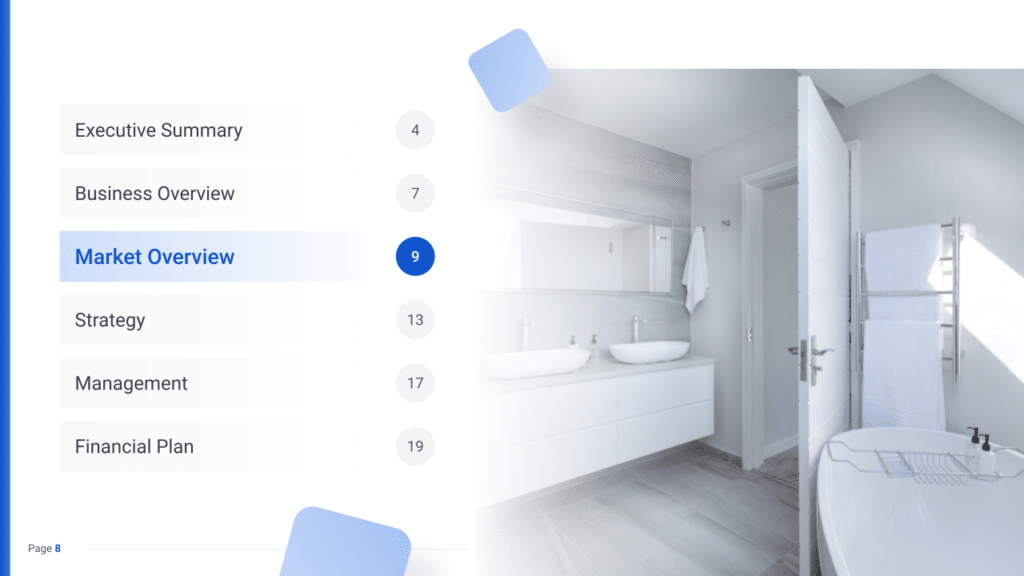
Industry Size & Growth
In the Market Overview of your Kitchen & Bathroom Remodeling business plan, start by evaluating the size of the remodeling industry and its growth prospects. This analysis is crucial for understanding the market’s breadth and pinpointing opportunities for expansion.
Key Market Trends
Proceed to discuss recent trends in the remodeling market, such as the growing consumer interest in smart home technology, energy-efficient appliances, and custom, sustainable materials. Highlight the demand for functional yet aesthetically pleasing spaces that cater to homeowners’ specific needs and preferences, alongside the increasing popularity of eco-conscious and technology-integrated remodeling solutions.
Competitive Landscape
A competitive analysis is not just a tool for gauging the position of your kitchen & bathroom remodeling business in the market and its key competitors; it’s also a fundamental component of your business plan. This analysis helps in identifying your kitchen & bathroom remodeling business’s unique selling points, which are essential for differentiating your business in a competitive market.
In addition, the competitive analysis is integral in laying a solid foundation for your business plan. By examining various operational aspects of your competitors, you gain valuable information that ensures your business plan is robust. Let’s dive in!
Identifying Key Competitors in the Remodeling Industry
Start your analysis by identifying direct and indirect competitors in the kitchen and bathroom remodeling sector. Direct competitors may include local remodeling firms specializing in kitchen or bathroom renovations, while indirect competitors could encompass interior design studios or general contractors offering remodeling services as part of their portfolio.
Utilize online resources such as local business directories, industry-specific platforms, and customer review sites like Houzz or Angie’s List to map out competitor locations and gather feedback. Reviews often highlight strengths and weaknesses; for instance, consistent praise for “Revamp & Renew Remodeling Co.” for their attention to detail could signify a strength worth noting.
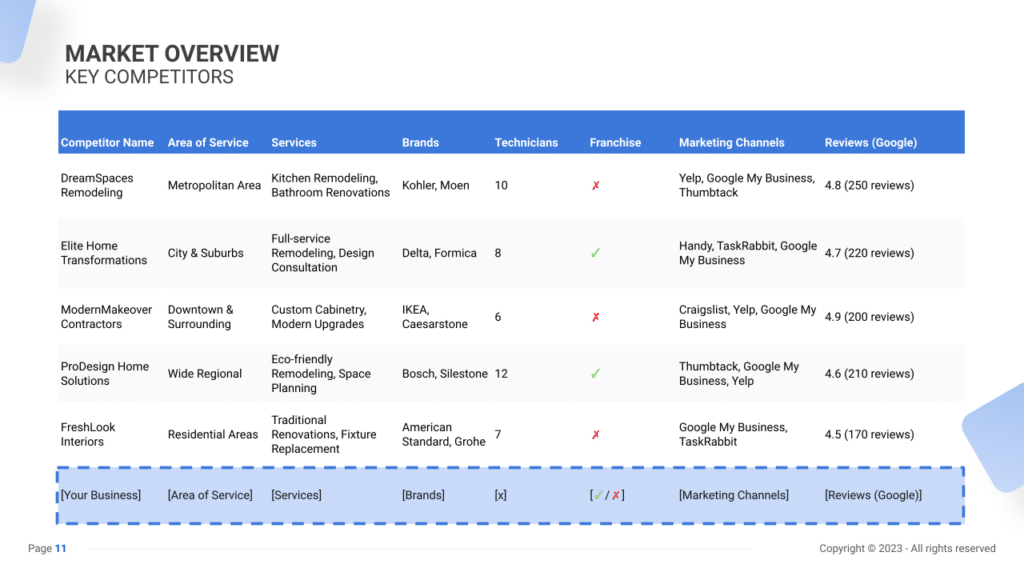
Kitchen & Bathroom Remodeling Business Competitors’ Strategies
Analyzing competitors involves dissecting various aspects of their strategies:
- Service Offerings: Evaluate the breadth and depth of services provided. For instance, a competitor might excel in luxury bathroom remodels, while another focuses on eco-friendly kitchen renovations, catering to specific clientele niches.
- Craftsmanship and Design Approach: Consider the craftsmanship and design philosophy employed by competitors. A firm known for sleek, modern designs might attract a different audience than one specializing in rustic, farmhouse-style renovations.
- Pricing Models: Compare pricing structures. Are your rates competitive with “Swift Renovations,” known for budget-friendly options, or are they more aligned with the high-end offerings of “Elegance Redefined Remodelers”?
- Marketing Strategies: Assess how competitors market their services. Are they leveraging digital platforms effectively, investing in SEO, or relying on traditional methods like referrals and local events?
- Customer Experience: Investigate customer experiences. “ComfortCraft Remodeling” might be praised for its project management skills and customer-centric approach, enhancing overall satisfaction.
- Operational Efficiency: Notice if competitors embrace innovative tools or technologies to streamline processes. “Efficient Home Solutions” may use virtual reality for design visualization, potentially impacting customer engagement.
What’s Your Business’s Value Proposition?
Define your remodeling business’s unique value proposition. Perhaps your specialization lies in sustainable materials, offering eco-conscious solutions not commonly found among competitors. Consider unique selling points, such as a quick turnaround time or specialized expertise in historical property renovations.
Identify market gaps by gathering customer feedback and observing industry trends. For instance, a surge in demand for smart home integration or universal design for aging-in-place could signify untapped opportunities if competitors aren’t fulfilling these needs.
Tailor your approach based on location demographics. A business situated in an affluent urban area might prioritize luxury and cutting-edge design, while one in a suburban setting could emphasize family-friendly, functional spaces.
Strategy
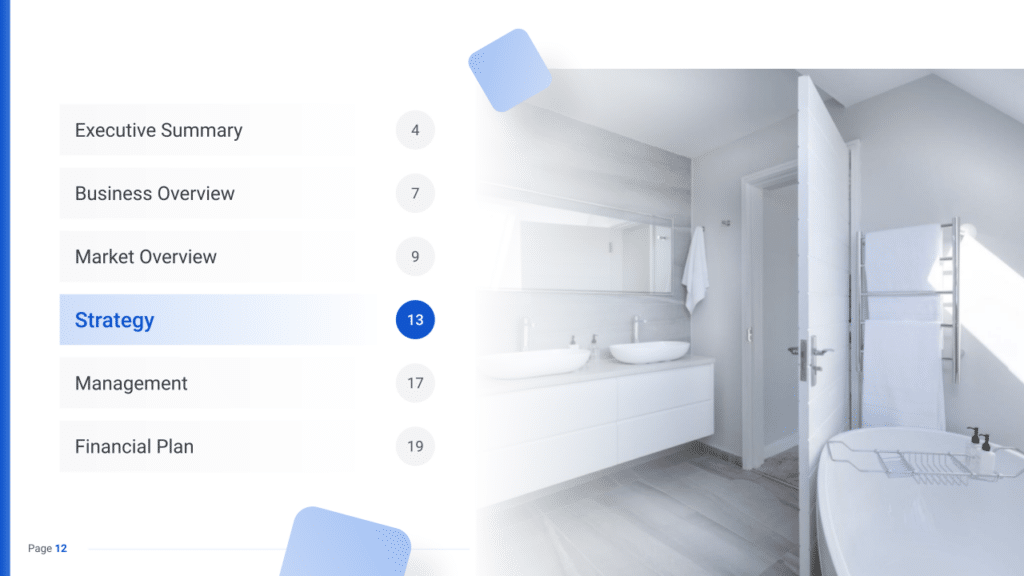
SWOT
First, conduct a SWOT analysis for your Kitchen & Bathroom Remodeling business, highlighting Strengths (such as high-quality craftsmanship and customized design solutions), Weaknesses (including dependency on suppliers or market fluctuations), Opportunities (for instance, the rising trend in home renovations and smart homes), and Threats (such as economic downturns that may reduce home improvement spending).
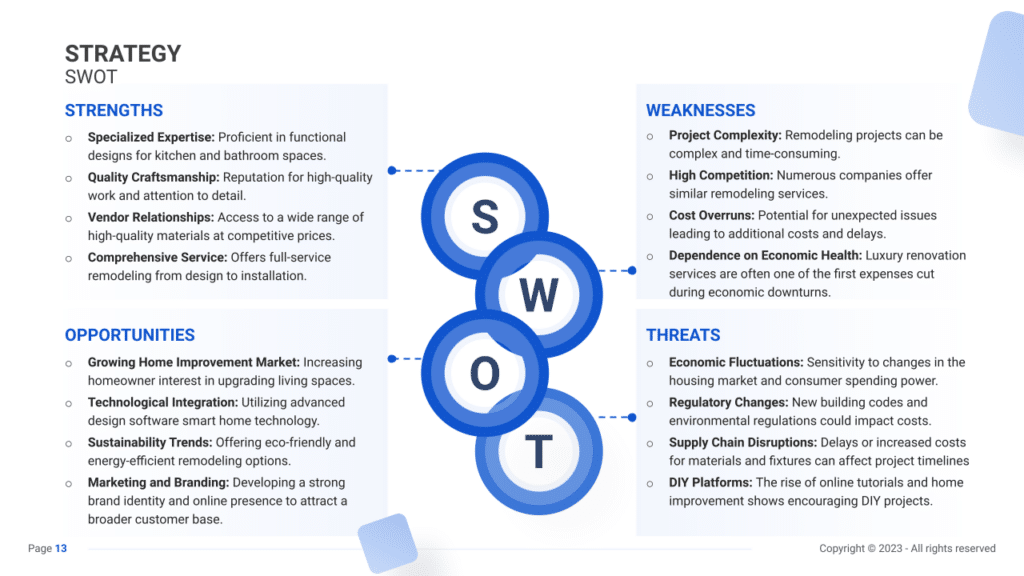
Marketing Plan
Next, develop a marketing strategy that outlines how to attract and retain customers through targeted advertising in home improvement magazines and websites, promotional offers for first-time clients, a strong online presence with before-and-after project galleries, and participation in local home shows and community events.
Marketing Channels
Utilize various marketing channels to effectively communicate your brand and services to potential clients and engage with your existing customer base.
Digital Marketing
Establish a strong online presence:
- Website and SEO: Create a professional website showcasing your portfolio, client testimonials, and educational remodeling content. Optimize it for local SEO to enhance visibility in searches related to remodeling services in your area.
- Social Media: Leverage platforms like Instagram and Houzz to showcase before-and-after remodeling projects and client reviews, and engage with your audience through informative posts and live videos.
- Email Marketing: Build an email list and regularly send newsletters containing remodeling tips, case studies, and exclusive offers to nurture client relationships.
Local Marketing Initiatives
Engage with the local community:
- Networking and Partnerships: Collaborate with real estate agents, interior designers, and home improvement stores for referrals or joint promotions. Participate in home expos, seminars, or local trade shows to showcase your expertise.
- Local Advertising: Advertise in community newsletters, home improvement magazines, and local radio stations. Utilize targeted online ads through platforms like Google Ads to reach potential customers in your locality.
Promotional Activities
Attract potential clients through enticing offers:
- Limited-time Offers: Introduce seasonal promotions such as ‘Spring Renovation Specials’ or ‘Holiday Kitchen Makeover Discounts’ to attract new clients and encourage repeat business.
- Referral Programs: Incentivize existing clients to refer friends or family by offering discounts or bonuses upon successful conversions.
- Free Consultations: Provide complimentary initial consultations to prospective clients, demonstrating your expertise and building rapport.
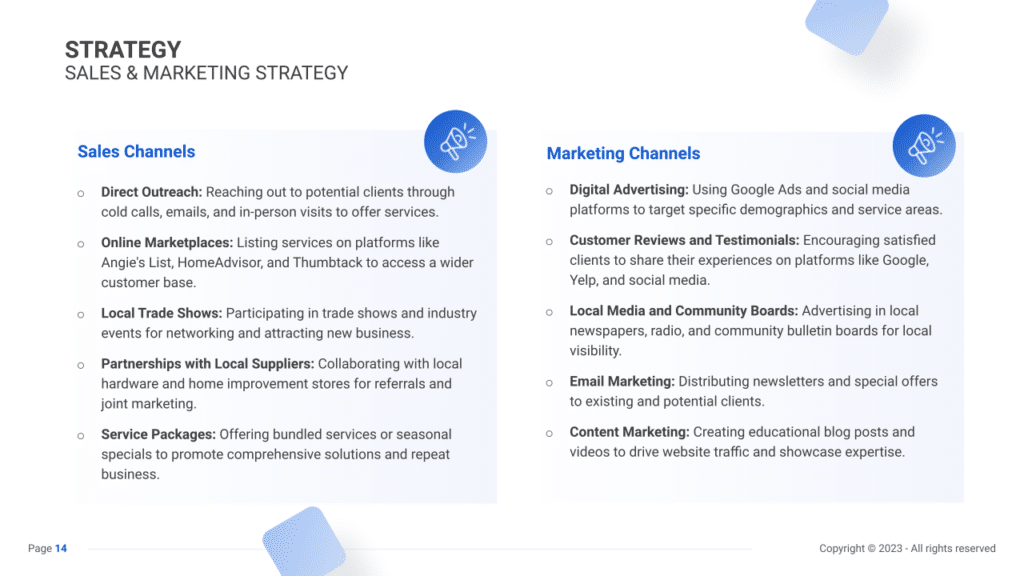
Sales Channels
Effective sales channels and strategies are crucial for converting leads into paying customers and maximizing revenue.
Consultative Selling
Understand client needs to tailor solutions:
- Educational Content: Develop and distribute informative content that educates potential clients about various remodeling options, material choices, design trends, and budgeting tips. Create downloadable resources, blog posts, or video tutorials that address common concerns and showcase your expertise.
- Transparent Quoting: Provide detailed and transparent quotes that outline the entire scope of work, associated costs, project timelines, and any potential variations. Ensure clarity and transparency to build trust and credibility with potential clients.
Upselling and Add-on Services
Maximize value during client interactions:
- Upgrade Options: During consultations or project discussions, present additional services or premium material options that enhance the overall quality, functionality, or aesthetics of the remodeling project. Highlight how these upgrades can significantly elevate the final result.
- Accessory Sales: Offer add-on products or accessory items that complement the remodeling projects. This could include designer fixtures, innovative appliances, smart home technology, or specialty finishes that enhance the overall appeal of the renovation.
Customer Retention Strategies
Foster long-term client relationships:
- Post-Project Follow-ups: Conduct post-project evaluations and follow-ups to ensure client satisfaction and address any post-installation concerns promptly. Request feedback or testimonials to showcase your commitment to delivering exceptional service.
- Maintenance Contracts: Offer ongoing maintenance contracts or annual check-ups to past clients. This ensures that their renovated spaces are well-maintained and offers an opportunity to upsell additional services or recommend upgrades for continued client engagement.
Strategy Timeline
Finally, create a detailed timeline that outlines key milestones for your business’s launch, marketing initiatives, customer base growth, and expansion goals, ensuring the business progresses with clear direction and purpose.

Management
The Management section focuses on the kitchen & bathroom remodeling business’s management and their direct roles in daily operations and strategic direction. This part is crucial for understanding who is responsible for making key decisions and driving the kitchen & bathroom remodeling business towards its financial and operational goals.
For your kitchen & bathroom remodeling business plan, list the core team members, their specific responsibilities, and how their expertise supports the business.
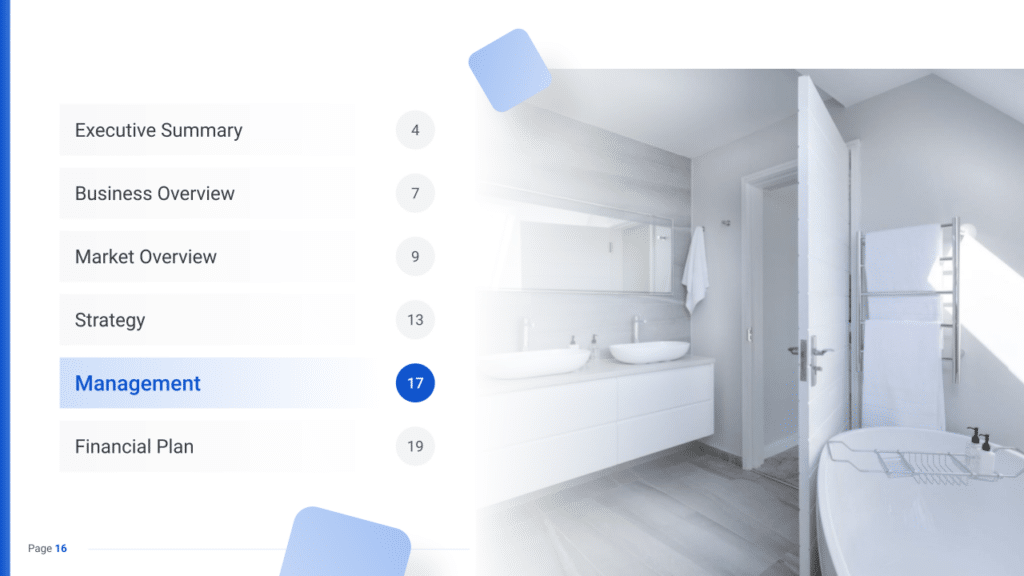

Financial Plan
The Financial Plan section is a comprehensive analysis of your financial projections for revenue, expenses, and profitability. It lays out your kitchen & bathroom remodeling business’s approach to securing funding, managing cash flow, and achieving breakeven.
This section typically includes detailed forecasts for the first 5 years of operation, highlighting expected revenue, operating costs, and capital expenditures.
For your kitchen & bathroom remodeling business plan, provide a snapshot of your financial statement (profit and loss, balance sheet, cash flow statement), as well as your key assumptions (e.g. number of customers and prices, expenses, etc.).
Make sure to cover here
_ Profit and Loss
_ Cash Flow Statement
_ Balance Sheet
_ Use of Funds
